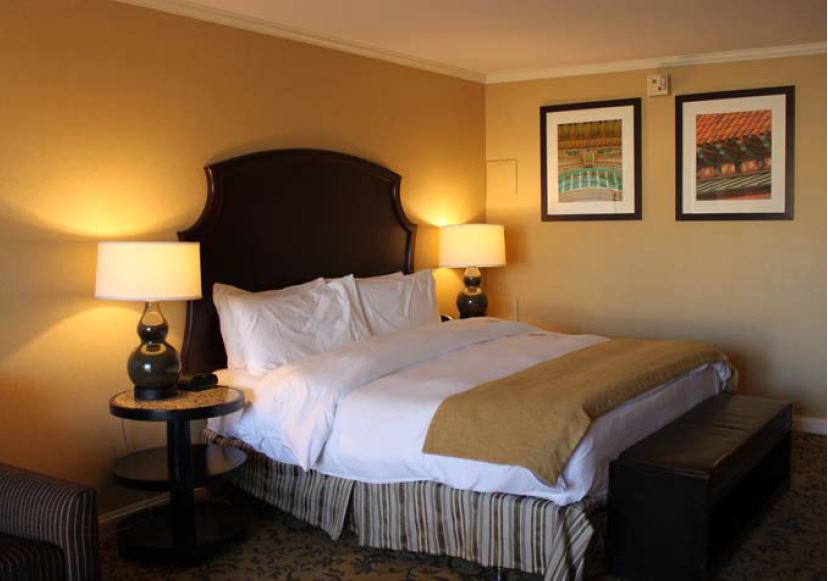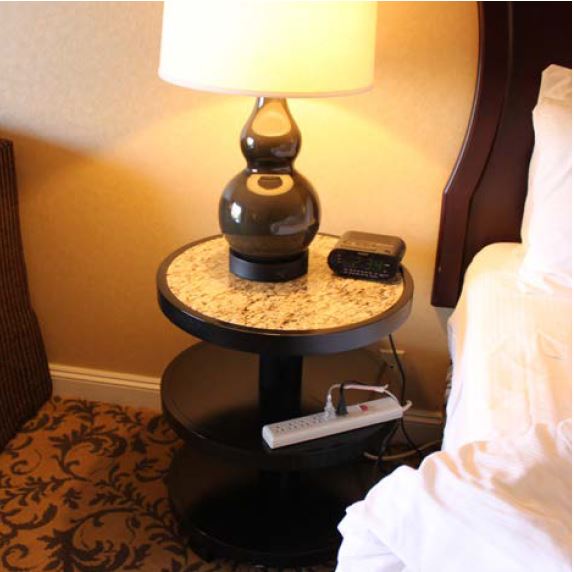Lodging: Beyond the ADA
Guest Rooms
Beds.
-
Bed heights for accessible rooms should be between 17-23 inches above the floor
Hotel bed height between 17-23”
-
Do not have border frame which prevents the wheelchair from being directly next to the mattress.
-
Avoid solid-sided bed frames or platforms. Use bed frames with open space between the floor and mattress to allow the use of portable lifts.
-
Do not use memory foam/form fitting mattresses or have platform bed frames. Memory foam mattresses are the least friendly for people with mobility limitations (they are also expensive mattresses).
-
This type of mattress forms around the body preventing easy movement for those with impairments.
Floors.
-
Consider wood (composite flooring) or laminate floors for easier access within guest rooms and wherever else possible. Carpet causes resistance that makes rolling much more difficult than on the aforementioned surfaces. Using these surfaces is also advantageous to customers with allergies as carpeting retains chemicals that adversely affect many people.
Extras.
-
Offer a refrigerator for individuals needing to store medicine and/or food for alleviating issues related to their disability.
-
It is important to provide clear access to all amenities in the room, including a curtain with a ringed rod for opening and closing. Electronic devices may also be used to open and close curtains.
Lamps and Outlets.
-
Lamps with outlets next to the bed are always preferred.
Nightstand with powerstrip. [sic]
-
If lamps are placed behind overstuffed chairs or other types of furniture, be sure to have a wall switch for activation.
-
Do not use lamps that require fine dexterity to activate.
-
Preference clearly is toggle switch lamps.
-
-
Provide or offer a multi-outlet extension cord next to bed.
-
At least two outlets should be within reach range wherever outlets are located.
Bathrooms.
-
When designing or remodeling rooms, strongly consider increasing the number of roll-in/walk-in shower rooms. Surveys indicate a vast majority of guests shower rather than bathe. This is a safety issue (less risk) as well as an accessibility issue.
-
If proper shower drainage is an issue, a channel drain the length of the shower to prevent water from escaping to the general bathroom floor is strongly recommended.
-
Be sure to cover the drain with some type of cross-grid cover.
-
-
Toilet seat and cover should be secured (generally, metal fasteners are more durable and secure than plastic fasteners). The torque of a person transferring from a wheelchair onto the seat necessitates this as transferring onto a toilet generally puts more force on the seat than when an able bodied person eases onto the seat.
-
Grab bars must be anchored in weight bearing studs, not in dry-wall.
-
Grab bars are required to support 250 PSI, however, 350 pounds is highly recommended.
-
-
Lights on timers in bathrooms are not recommended. Sometimes the light does not stay on long enough and guests find themselves in the dark trying to transfer from a wet shower bench back into their wheelchairs.
Service
Respect.
-
Train staff to ask people with disabilities if they need assistance using hospitality language and practices.
-
Keep lowered check-in counter clear. Where only high counters are available (older lodging facilities) train staff to come out from behind counter and provide a clipboard.
-
If a lower counter is not available, have a clipboard available as an alternative.
-
-
Make sure customers feel comfortable about asking for room rearrangement or additional room modifications at check-in.
-
You cannot charge pet fees for service animals. Legally, staff may only ask if a dog is a service animal and what task it preforms.
-
There is no certification card or placard required for service animals, nor one that is recognized by the federal government.
-
Orient.
-
Make sure accessible paths of travel are clearly marked with proper signage.
-
Offer orientation to the facility layout for visually impaired customers.
-
When guiding a customer with a visual impairment, describe the layout in detail and alert the customer to changes in level, doorways, and turns in advance.
-
If a customer has a service dog, alert them to the locations of green space and how to access these areas.
-
Communicate.
-
Provide sign language charts for basic hospitality communication at check-in, restaurants bell stands, coffee shops, etc.
-
Utilize smart phone features for communicating. (ex: order room service via text).
-
Use a larger font for menus and information. Many travelers are older and have some degree of vision limitation.
-
A 16 point font is recommended.
-
Details.
-
If you have buffets, offer cafeteria-style trays and/or personal assistance.
-
When delivering room service, allow adequate response time for the guest answer the door.
Housekeeping
-
Ensure the shower head is placed at its lowest level on the rod.
-
Ensure toiletry items are placed within reach limits for those with limited reach range.
-
Towels must be within reach range -no higher than 48 inches.
-
Do not place towels on the grab bars. (Note pg. 10)
-
Provide a rubberized bath mat for bathrooms. This will help prevent wheelchairs from sliding during transfers and provides greater stability for standing guests.
-
If a room is rearranged by the guest with a disability staying multiple nights, do not relocate the furniture until checkout.
-
Coffee pots should be easily connected and operated within reach ranges.
-
Cleaning carts should be placed to the side of the hallways so guests using wheelchairs have space to pass.
-
Reminder: Do not place any tables, furniture, or other items on the pull-side of the door to the room, which could prevent a person from opening/closing the door. (18 inches clear required)
Website Access
-
Reservation systems must be usable by people with different types of disabilities.
-
For the visually impaired and others using screen readers the website should meet WCAG 2.0 minimum standards. (see resources pg. 21)
-
At minimum, use web accessibility validation tools for all sites and pages.
-
-
Make the choice/need for an accessible room type easily found on the first page of the registration process. Specify accessible tub rooms from roll-in shower rooms.
-
Provide a video and/or pictures highlighting hotel and guest room accessibility features on registration web pages.



User Comments/Questions
Add Comment/Question